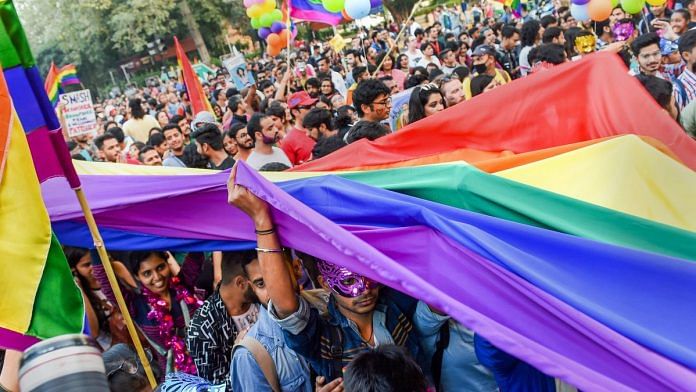
Thank you dear subscribers, we are overwhelmed with your response.
Your Turn is a unique section from ThePrint featuring points of view from its subscribers. If you are a subscriber, have a point of view, please send it to us. If not, do subscribe here: https://theprint.in/
“Bhaina, would kinnar be found here by any chance?”
The local vendor selling dahi-vadas at Jaydev Vihar, Bhubaneswar, shifted uncomfortably, preferring silence over a conversation about “kinnar,” a socio-cultural community of transgender people. After pondering for a few minutes and without looking up from his work, the vendor said with visible hesitation, “Yes madam. They come here every day to beg on the streets near the red lights. They’re not here today.” The relief in his voice when he mentioned the kinnars’ absence was obvious.
Such behaviour is common in India; many people grow uncomfortable when discussing transgender persons, fumble when questioned about them, or choose to completely ignore the community. Such individuals are nevertheless preferable to the numerous others who continue to harass and discriminate against trans and non-binary people based on their gender expression. Years after laws prohibiting discrimination against trans people were implemented, the community continues to deal with prejudice at every stage of life, including when pursuing an education.
Fifteen minutes away from the hubbub of Jaydev Vihar comes Nalco Chak, where I came across Baby, 27, and Bijuli, 33, two kinnar women who were begging for alms and offering blessings in exchange. They spoke extensively about their two vastly disparate experiences. Baby holds a bachelor’s degree in the arts, but the entire process of getting the degree was marred by bullying and harassment because her gender expression did not match her gender identity. She decided to pursue distance learning after her first year of college because she felt unsafe in her college environment. On the other hand, Bijuli’s parents passed away when she was in class 3, therefore she was unable to complete her basic education. Her Guru assisted her in making a living for 15-20 years after the rest of her family refused to support a “strange” child. Both women had trouble finding suitable jobs because their workplaces, like many others across the nation, did not accommodate the rights of transgender individuals. In Baby’s case, this was true even after she received a degree.
Naina (they/she), a non-binary second-year undergraduate student at a reputable private university in Bhubaneswar, had a very different experience. The support from parents, classmates, and, to some extent, teachers is the one stark and important difference between them and Baby or Bijuli, despite the fact that they have faced similar instances of bullying and harassment. Naina was able to come out of the closet while continuing their schooling thanks to support, and the opportunity to access mental healthcare facilities.
From these three very different perspectives, the following points can be made on the issues and possible solutions for creating a safe space for trans and non-binary youth:
- Gender studies must be incorporated into school curricula if people are to properly comprehend the notions of gender and sexuality beyond the traditional boundaries of the binary male/female. Increasing pupils’ awareness of persons of various genders, the problems they encounter, and the importance of mutual respect would reduce discrimination.
- Teachers must also be made aware of their impact on the lives of transgender and non-binary students. The most common ways that teachers misgender their pupils are by using improper pronouns and/or dead names, as experienced by Naina, or by denying them access to education because their gender identity does not match their gender expression, as Baby encountered during the college admissions process. Teachers’ compassion and respect can be crucial in helping to create environments that are safe for transgender students.
- The gender binary-conforming school regulations need to be reviewed. Baby stated that she was not allowed to freely express her gender expression due to school policies such as the recommended haircut for male students and the gender-binary uniforms. It’s past time for schools to understand that students’ academic abilities are not influenced by their appearance, and that being at ease in a classroom setting would be preferable to being coerced into clothes and hairstyles that foster body and gender dysmorphia.
- Gender-neutral washrooms can especially help trans and non-binary youth who have not transitioned/are in the process of transitioning, since they may face extreme discomfort in having to use washrooms which do not conform to their identified gender.
- Schools for transgender persons seeking an education at any stage in their life should be established. To encourage them, transgender persons must be made aware of the need for education, the importance, and the advantages it can produce.
As Naina pointed out, people who identify as transgender or non-binary frequently feel misunderstood in our cis-heteronormative culture. They have the same right to education as anyone else. No one owes each other anything except respect, which should translate into making safe spaces for trans and non-binary people so that they can become more visible in academic settings.
Also read: Jamali Kamali, hijron ka khanqah, Sarmad’s tomb — Delhi history’s safe spaces for LGBTQ
These pieces are being published as they have been received – they have not been edited/fact-checked by ThePrint.

COMMENTS